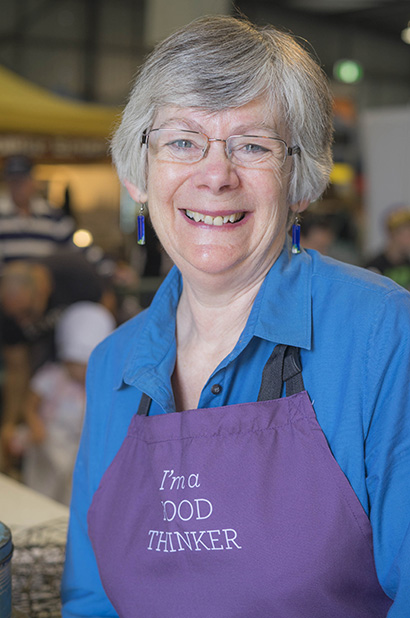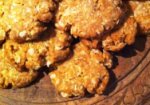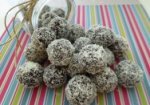This handsome handmade tea cosy was made from a black silk skirt panel that belonged to Bessie Rouse (b.1843, d.1924). The cosy, and remarkably, the remnants of the skirt, complete with tea-cosy-shaped hole in it, remain in the Rouse Hill House and Farm collection. The tea cosy is an example of commemorative craft from the first World War period. It honours the 54th battalion which was active in Egypt and France between 1916 and 1918 and depicts the official design of the Rising Sun emblem that was used between 1904 – 1949.
The other commemorative craft that survives today is of course, the Anzac biscuit. Culinary historian Allison Reynolds has been on her own combat mission to discover the origins and evolution of the Anzac biscuit, and is on a quest to find the earliest reference for the classic oat biscuit as an ‘Anzac’. Allison is guest blogger this week, sharing her findings on the power and spirit of the Anzac biscuit.
The power and the spirit of the Anzac biscuit: unique, unusual and uniting.
The Anzac biscuit holds a particular significance to Australians and New Zealanders and is recognised as a distinctly national food in both countries. Currently many myths, legends and misconceptions surround the Anzac biscuit, and in view of the approaching centenary in 1915, it is vitally important to have an authoritative reliable history of the biscuit. There has been much interest in the Anzac biscuit’s origins among food scholars in recent years. Where did it come from; who added the coconut or which cookery book published the first recipe? Important as all these and other issues are in the history of the biscuit, my research (which will eventually reveal answers to all these questions and more) shows that there is far more to this iconic biscuit. For several years now I’ve been gathering evidence from cookery books, soldiers’ letters, newspapers and archival material from libraries and private collections from across Australia and in particular, public appeals for family recipes to discover the biscuit’s origins. However the powerful significance of uncovering that Anzacs (as they are fondly known) are unique, unusual and uniting has, in culinary terms, turned out to be “the icing on the cake.”
Unique …
Anzacs are unique. No other national food has come about as a result of the vagaries of war. Almost a century later they continue to be baked in homes throughout Australia and New Zealand. These biscuits are special because they honour and represent the courage and determination of the ANZAC forces. They are an edible symbol of the spirit of the ANZACs.
Unusual …
Anzac biscuits are unusual. These biscuit are ‘ordinary’ (everyday) and yet extraordinary too. They are eaten all year round – popular because they are delicious. No special baking skills are required. They can be baked by anyone and children especially enjoy making them. They are quick and easy to produce, use inexpensive store cupboard ingredients and keep well. However, they are also extraordinary – this popular and practical rolled oat biscuit has become associated with the spirit of the Diggers and they soon became known as Anzac biscuits. They are made especially around ANZAC day, where they are a constant for commemorations all over the world. They are also baked as a fund raiser for the Returned Services League (RSL). These biscuits are now powerfully connected to our cultural identity and commemoration.
Uniting …
Anzac biscuits are uniting. They are iconic national foods in Australian and New Zealand and while the Pavlova may divide us it is the Anzac that unites us – they are part of our shared heritage. These biscuits evolved during the First World War simultaneously in both countries. The Anzac biscuit is currently being baked by Brisbane city home bakers and sent to drought stricken farmers in regional Queensland by ‘Baked Relief’. This action has inspired the nation by uniting the city and the bush through the spirit of what the Anzac biscuit represents. Anzacs unite us all – whether you bake them yourself or buy them. It is a purposeful and positive way of showing allegiance, embraced by those born here and those who have settled in Australia. Not everyone is eligible to march on ANZAC day, not everyone has a medal inherited through the family, or even an ancestor who fought in the war, and not everyone is a member of their local RSL, but everyone can bake Anzac biscuits.
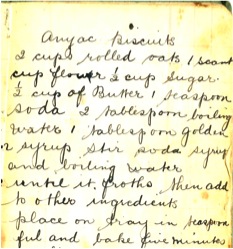
Anzac biscuit recipe from Carolyn Warner’s recipe notebook c1920. Photo courtesy and © Allison Reynolds
A call to arms!
A public callout for historical evidence of ‘Anzac’ biscuits produced a hand written recipe in a pre-1920s ledger book. The note book was compiled in Victoria by Carolyn Warner between 1912 and 1920 and is now owned by her granddaughter, Carol Moore. It’s not quite the ‘modern’ ‘accepted’ ‘traditional’ recipe that we use today, but is clearly an early version of what has eventuated to be the classic Anzac. It’s really worth a try – less sugar, flour and no desiccated coconut – but double the oats!
The original Anzac biscuit? circa 1920
Ingredients
- 200g rolled oats
- 125g plain flour
- 100g sugar
- 125g butter
- 2 tablespoons golden syrup
- 1 teaspoon bicarbonate of soda (bi-carb soda)
- 2 tablespoons boiling water
Note
Culinary historian Allison Reynolds is author of 'Anzac Biscuits, the power and spirit of a national icon'. She has kindly shared this recipe which is based on a hand written recipe found in a notebook that belonged to Carolyn Warner in South Australia. Research indicates that it was compiled before 1920, and is one of the earliest recipes to identify the now iconic oat and golden syrup biscuit as an 'Anzac'.
This recipe has less sugar, flour and no desiccated coconut – but double the oats than the more familiar modern-day versions. The original handwritten recipe asks for 1 tablespoon of golden syrup, but experience with this recipe suggests that it was a very generous measure, and works best with 30 mls.
Directions
| Pre-heat oven to 180°C. Put the oats, flour and sugar into a large bowl and mix well. Melt the butter in a large saucepan over medium heat and add the golden syrup (see the Cook’s tip below). Stir till dissolved and just coming to the boil, then remove from the heat (but don’t allow it to cool). Place the boiling water into a small cup, add the bicarbonate of soda and stir until it is dissolved, then add the soda mixture to the saucepan of butter and syrup. Stir until it froths, and immediately add the hot mixture to the dry ingredients and mix all together. | |
| Check mixture is cool enough to handle, then take a flat dessertspoon of the mixture, place it in your hand, and bring together by rolling into a ball. Place 5 cm apart on the baking sheet (they will spread), flattening slightly – use the base of a glass or press down with a fork, dipped in a little flour (this will stop the glass or fork sticking). Put trays in the oven for 15–18 minutes until golden (they will still be soft). Leave the biscuits on the trays for 5 minutes before transferring them to a cooling rack. When the biscuits are cold store them in an airtight tin. | |
| Cook’s tip – when measuring out the golden syrup, dip the tablespoon into hot water so that it slips from the spoon easily, or warm the bottle or tin of syrup by standing in hot water so it isn’t too thick to pour. | |
About Allison
Allison has a Master of Arts (Gastronomy) from the University of Adelaide. She runs the South Australian Cookbook Road Show, engaging with rural communities through old cookery books. While looking at old published cookery books and inherited family recipe books Allison noticed that early Anzac biscuit recipes did not include coconut (or cocoanut as it was then known). Suddenly the quest was on to discover who put the coconut in the Anzac biscuit? And, while we were at it – Why not find out where the biscuit came from? Did it originate from the Scottish oatcake as is commonly thought? Were biscuits posted to the soldiers’ at the front as we would all like to believe? There were many questions that needed answers! Allison is working towards a book on the origins and evolution of the Anzac biscuit and what it represents today. You can find Allison on her culinary history facebook page.
Further reading on the history of the Anzac biscuit: Anzac biscuits – a culinary memorial by Sian Supski
And on the ANZAC commemoration and traditions: Australian War Memorial, The 54th battalion, The Rising sun emblem
Sources Australian War Memorial; Australian Army.
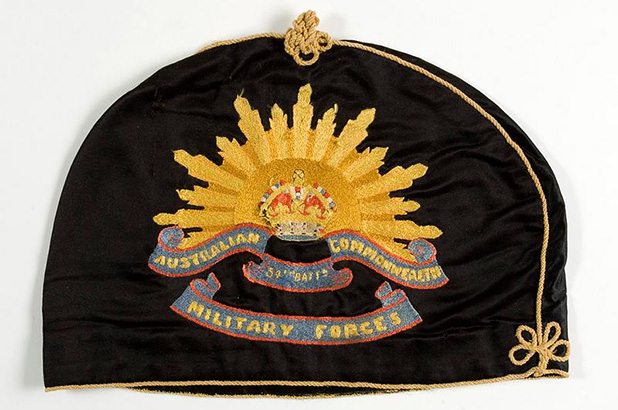
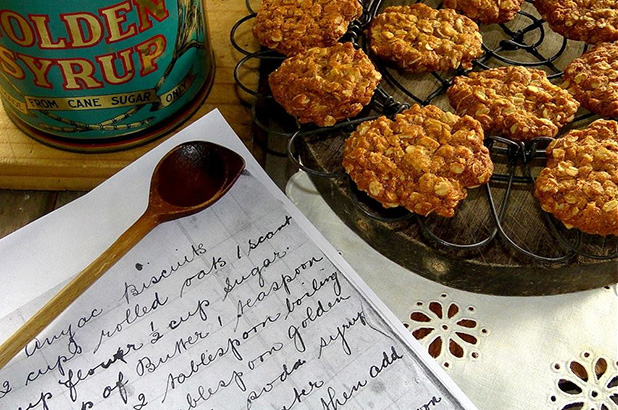
 Print recipe
Print recipe